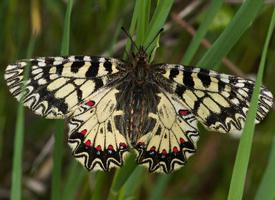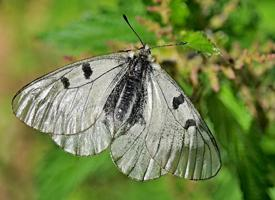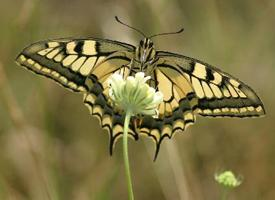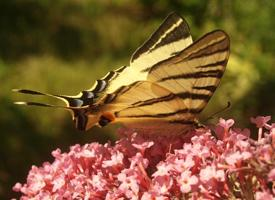
Váhy a míry
| Délka rozpětí křídel | od 46 do 55 mm |
|---|
Popis zvířete
The Southern Festoon (Zerynthia polyxena) is a captivating butterfly species belonging to the Papilionidae family, which is renowned for its striking appearance and unique behavioral characteristics. This butterfly is predominantly found across Southern Europe and extends into Asia, favoring warm, temperate climates. Its habitats are diverse, ranging from flowery meadows and woodland clearings to lush valleys, where it thrives amidst rich biodiversity.One of the most striking features of the Southern Festoon is its wings. The wingspan of this species can reach up to 52-60 mm, displaying a remarkable pattern that serves as a visual feast. The background color of the wings is a creamy white, adorned with a complex pattern of black, yellow, and red markings. These vibrant colors are not just for show; they play a crucial role in predator deterrence, signaling toxicity or unpalatability to potential threats. The intricate design of the wings, coupled with its fluttering flight, makes the Southern Festoon a mesmerizing sight in its natural habitat.
The lifecycle of Zerynthia polyxena is equally fascinating. The eggs are laid on host plants, specifically species belonging to the Aristolochia genus. Upon hatching, the larvae feed on these plants, which contain toxic compounds that the caterpillars are immune to. These toxins are retained in the body of the caterpillar and carried over to the adult butterfly, providing them with a chemical defense mechanism against predators. The caterpillar itself is a sight to behold, with a distinctive appearance that includes a series of spikes along its body, adding to its defense strategy.
The metamorphosis from caterpillar to butterfly is a critical phase in the life of a Southern Festoon. The chrysalis, or pupa, stage is where the transformation occurs, leading to the emergence of the adult butterfly. This process of metamorphosis is a remarkable example of nature's ingenuity, showcasing the intricate changes that occur within the chrysalis.
Southern Festoons are diurnal, meaning they are active during the day, particularly in the warmth of the late morning and early afternoon. During this time, they can be seen fluttering from flower to flower, feeding on nectar. Their preference for a variety of flowering plants contributes to their role as pollinators, facilitating the reproduction of many plant species.
The presence of the Southern Festoon is often considered an indicator of a healthy, biodiverse ecosystem. However, like many species, it faces threats from habitat destruction, pollution, and climate change. Conservation efforts are crucial to ensure the survival of this remarkable butterfly, requiring the protection of its natural habitats and the plants the larvae feed upon.
In conclusion, the Southern Festoon (Zerynthia polyxena) is a butterfly of extraordinary beauty and fascinating biology. Its vibrant wings, intricate lifecycle, and ecological role make it a subject of interest not only for lepidopterists but for anyone who appreciates the wonders of the natural world. As we strive to protect and preserve the environments that nurture such incredible species, the Southern Festoon serves as a reminder of the delicate balance within ecosystems and the beauty that resides within them.
Podobná zvířata
Nové fotografie zvířat
Top 10 zvířat
- Elephant hawk moth (Deilephila elpenor)
- Common house mosquito (Culex pipiens)
- Australian box jelly (Chironex fleckeri)
- Fruit fly (Drosophila melanogaster)
- Wasp spider (Argiope bruennichi)
- Colossal squid (Mesonychoteuthis hamiltoni)
- Bee hummingbird (Mellisuga helenae)
- Common cockchafer (Melolontha melolontha)
- Waitaha penguin (Megadyptes waitaha)
- Common reed warbler (Acrocephalus scirpaceus)


